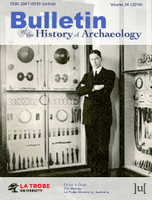
Bulletin of the History of Archaeology
Scope & Guideline
Fostering Dialogue and Discovery in Archaeological Scholarship
Introduction
Aims and Scopes
- Historical Contextualization of Archaeology:
The journal provides a platform for examining the historical roots and evolution of archaeological practices, methodologies, and theories across different cultures and time periods. - Interdisciplinary Approaches:
It encourages interdisciplinary research that integrates archaeology with other fields such as anthropology, history, and geography, fostering a holistic understanding of archaeological narratives. - Critical Examination of Archaeological Practices:
The journal critically analyzes various archaeological practices and their implications, particularly in relation to issues of ethics, representation, and the politics of heritage. - Focus on Global Perspectives:
It highlights research that brings forth non-Western perspectives and contributions to archaeology, ensuring a more inclusive narrative in the historical discourse. - Engagement with Current Debates:
The journal engages with contemporary debates in archaeology, including discussions around race, inequality, and the impact of colonial legacies on archaeological practices.
Trending and Emerging
- Intersections of Archaeology and Politics:
Recent publications increasingly explore the interplay between archaeology and nationalism, colonialism, and politics, highlighting how archaeological narratives can shape national identities and historical consciousness. - Revisiting Historical Figures and Theories:
There is a growing interest in revisiting historical figures in archaeology, such as Gordon Childe, and their contributions, encouraging a re-examination of foundational theories and methodologies in light of contemporary issues. - Ethnoarchaeology and Indigenous Perspectives:
Emerging themes emphasize the importance of ethnoarchaeology and indigenous perspectives, advocating for the inclusion of local knowledge systems and practices in archaeological discourse. - Gender and Representation in Archaeology:
The journal has begun to focus more on gender studies within archaeology, particularly the roles of women and marginalized groups in historical narratives and archaeological practices. - Pluriversal Histories of Archaeology:
There is a trend towards developing pluriversal histories that acknowledge diverse viewpoints and experiences in archaeology, moving away from Eurocentric narratives to more inclusive histories.
Declining or Waning
- Traditional Archaeological Methodologies:
There is a noticeable decrease in publications focusing on traditional archaeological techniques, such as excavation methods and stratigraphy, as the journal increasingly emphasizes theoretical and historical discussions. - Regional Archaeology Studies:
Research centered on specific regional studies has waned, with fewer papers dedicated to localized archaeological findings, possibly due to a growing preference for broader, more global analyses. - Technical Innovations in Archaeology:
While technology in archaeology remains important, discussions specifically about technical innovations, such as new tools or machinery used in excavation, appear to be less frequent in recent publications. - Focus on Material Culture:
The analysis of material culture as a standalone topic has diminished, as the journal seems to prioritize socio-political contexts over purely materialistic interpretations.
Similar Journals

Studijne Zvesti Archeologickeho Ustavu Slovenskej Akademie Vied
Connecting local insights with global archaeological discourse.Studijne Zvesti Archeologickeho Ustavu Slovenskej Akademie Vied is a leading journal in the field of archaeology, published by the SLOVENSKA AKAD VIED, ARCHEOLOGICKY USTAV, based in Nitra, Slovakia. This esteemed journal, with the ISSN 0560-2793, has established itself as a vital resource for scholars and researchers, reflecting significant academic contributions in both the arts and humanities as well as social sciences. With a 2023 Scopus ranking placing it in the second quartile (Q2) for archaeology, it showcases rigorous research and innovative methodologies, essential for advancing archaeological studies. While it is not an Open Access journal, it continues to offer valuable insights into archaeological findings, theoretical frameworks, and interdisciplinary approaches. The journal serves as a bridge, connecting local Slovak archaeology with international discourse, making it an indispensable tool for students, professionals, and academics striving for a deeper understanding of the archaeological heritage of Slovakia and beyond.
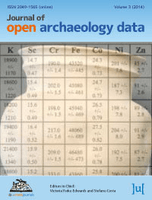
Journal of Open Archaeology Data
Advancing Knowledge in Archaeology, One Data Point at a Time.Journal of Open Archaeology Data, published by UBIQUITY PRESS LTD, is a pioneering open access journal dedicated to the dissemination of archaeological data and research since 2012. With an ISSN of 2049-1565, this esteemed journal plays a crucial role in fostering collaboration and transparency within the archaeological community. By offering an open access model, it encourages unrestricted access to a wealth of data and findings, facilitating innovative research and education across the globe. The journal has garnered recognition in the Scopus database, achieving impressive rankings in both the Arts and Humanities and Social Sciences categories. In 2023, it ranks in the top quartile (Q2) of archaeology journals, reflecting its influence and the quality of research it publishes. Operating from the heart of London, the journal serves as a vital platform for researchers, professionals, and students alike, aiming to advance knowledge and practice in archaeology through the sharing of original research and data-driven studies.

ArcheoSciences-Revue d Archeometrie
Exploring New Horizons in Archaeometric ResearchArcheoSciences-Revue d Archeometrie is a prominent scholarly journal dedicated to the field of archaeology, published by PRESSES UNIV RENNES in France. With an ISSN of 1960-1360 and an E-ISSN of 2104-3728, this journal has gained recognition for its focus on the intersection of science and archaeological research, aiming to foster interdisciplinary dialogue and innovative methodologies within archaeological studies. Although coverage of the journal has been discontinued in Scopus post-2021, it has maintained a respectable standing with a Q3 Quartile ranking in both the Archaeology (Arts and Humanities) and Archaeology categories as of 2023, as well as commendable Scopus rankings in relevant fields. As an accessible platform for researchers, professionals, and students, ArcheoSciences offers valuable insights into applied techniques and findings in archaeological science, making it an essential resource for those involved in the historical and cultural analysis of material relics. Researchers are encouraged to explore this journal to stay informed about frontier research and ongoing discussions in the discipline.
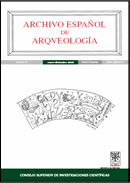
Archivo Espanol de Arqueologia
Advancing archaeological knowledge through open access.Archivo Español de Arqueología is a prestigious journal published by the Consejo Superior de Investigaciones Científicas (CSIC), dedicated to the field of archaeology and the historical sciences. Since its transition to Open Access in 1991, this journal has been a significant resource for scholars and practitioners in Spain and beyond, ensuring the dissemination of high-quality research to a broad audience. With an impressive Scopus ranking that places it within the top 20% of journals in the disciplines of History and Archaeology, Archivo Español de Arqueología plays a crucial role in advancing academic discourse and promoting innovative archaeological methodologies. The journal has maintained rigorous standards, reflected in its placement within the Q2 and Q3 quartiles, enabling it to establish a reputation for excellence and reliability in archaeological scholarship. Researchers, professionals, and students are encouraged to explore the journal's diverse array of articles from its foundation year of 2009 to the present, enriching their understanding of the past through the latest findings and theoretical advancements in archaeology.

Bulletin of the American Society of Overseas Research
Uncovering the past, shaping the future of cultural studies.Bulletin of the American Society of Overseas Research, published by the University of Chicago Press, serves as a premier platform for scholarly discourse in the fields of archaeology, cultural studies, and history. With its ISSN 2769-3600 and E-ISSN 2769-3589, this journal has swiftly established itself as a key resource for researchers, professionals, and students alike, demonstrating exceptional impact as evidenced by its Q1 rankings in multiple relevant categories for 2023. Notably, it holds the 93rd percentile rank in Arts and Humanities (History) and the 84th percentile in Social Sciences (Cultural Studies), evidencing its respected standing within the academic community. The journal's commitment to advancing knowledge and fostering interdisciplinary dialogue is complemented by its accessible publication from 2022 to 2024, making it an essential read for those engaged in the exploration of global cultural histories and archaeological research.
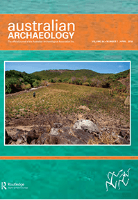
AUSTRALIAN ARCHAEOLOGY
Illuminating Australia’s Archaeological Treasures.AUSTRAILIAN ARCHAEOLOGY, published by Taylor & Francis Ltd, is a leading academic journal dedicated to the field of archaeology. With a strong reputation as evidenced by its Q1 ranking in both the Arts and Humanities and Social Sciences categories, this journal fosters the growth and dissemination of pioneering research from diverse archaeological contexts. The journal has been a vital resource for scholars and practitioners since its convergence in 2002, supporting the collective advancement of knowledge in the archaeological discipline. By offering a platform for rigorous analysis and critical discussions, AUSTRAILIAN ARCHAEOLOGY appeals to a wide audience, from established researchers to students beginning their journey in archaeology. Although it is not an Open Access journal, the insights provided are invaluable for enhancing understanding and appreciation of Australia’s rich archaeological heritage. With a Scopus ranking that places it among the top contenders in its field, this journal continues to contribute significantly to outstanding archaeological scholarship and professional practice.

Conimbriga-Revista de Arqueologia
Advancing Archaeological Knowledge for a Richer TomorrowConimbriga-Revista de Arqueologia is a distinguished open-access journal dedicated to the field of archaeology, published by COIMBRA UNIVERSITY PRESS. Since its inception, the journal has fostered a vibrant intellectual community focused on the exploration and dissemination of archaeological research, particularly emphasizing studies relevant to the rich historical and cultural heritage of Portugal and beyond. With its open access model established in 2014, it has become a vital resource for researchers, professionals, and students to share their findings without access barriers, encouraging collaboration and knowledge exchange. Despite the absence of specific metrics such as the HIndex and Scopus rankings, the journal is recognized for its commitment to high-quality scholarship and its role in advancing archaeological discourse. Positioned within the scholarly landscape, Conimbriga-Revista de Arqueologia serves as a crucial platform for the publication of innovative research, reviews, and critical essays, making it an essential journal for those invested in the archaeological sciences.

ARCHAEOLOGY
Exploring the Past, Illuminating the PresentARCHAEOLOGY is a distinguished peer-reviewed journal published by the Archaeological Institute of America, focusing on the multifaceted aspects of archaeological research and its relevance to contemporary society. Established in 1966, this journal serves as a critical platform for scholarly discourse in the field, showcasing innovative findings, theoretical advancements, and methodological discussions related to archaeology. While it maintains a Q4 ranking within the disciplines of archaeology and arts and humanities, its contributions remain valuable for those engaging in archaeological studies or seeking to understand historical and cultural narratives. The journal is accessible in print, with an ISSN of 0003-8113 and an E-ISSN of 1943-5746, ensuring that a wide audience can benefit from its insights. Although currently not classified as Open Access, the meticulous peer-review process ensures a high standard of academic rigor, making it an essential source for researchers, professionals, and students alike who are dedicated to exploring the past through archaeological lenses.
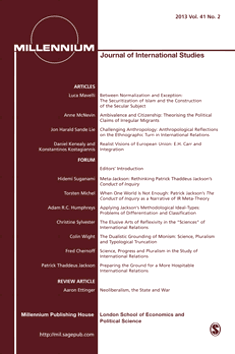
MILLENNIUM-JOURNAL OF INTERNATIONAL STUDIES
Pioneering Research in International RelationsMILLENNIUM: JOURNAL OF INTERNATIONAL STUDIES, published by SAGE PUBLICATIONS LTD, is a leading academic journal in the realms of political science and international relations. Established in 1971, this prestigious publication has continuously provided a critical forum for innovative and rigorous scholarship that challenges conventional perspectives and advances theoretical knowledge. With an impressive 2023 Scopus rank of #156/706 in Political Science and International Relations, and a prominent Q1 category ranking reflecting its influence and reach, MILLENNIUM stands at the forefront of contemporary debates in sociology and politics. Researchers and professionals keen to stay engaged with the latest findings and discussions in these fields will find this journal invaluable. While not an open-access outlet, MILLENNIUM ensures wide dissemination of impactful research and maintains a rigorous peer-review process, making it an imperative resource for scholars and students alike. With a commitment to exploring the intricacies of global and societal issues, this journal is essential for anyone looking to deepen their understanding of international affairs.
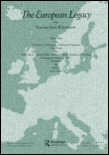
European Legacy-Toward New Paradigms
Advancing Interdisciplinary Dialogues on Cultural LegaciesEuropean Legacy-Toward New Paradigms is a distinguished academic journal published by Routledge Journals, Taylor & Francis Ltd, focusing on interdisciplinary approaches to cultural studies, history, and philosophy. With an ISSN of 1084-8770 and an E-ISSN of 1470-1316, this journal has made significant contributions to the understanding of European heritage and its impact on contemporary thought and society since its inception in 2001. It currently holds a Q3 ranking in Cultural Studies, History, and Philosophy, reflecting its relevance and scholarly impact within the academic community. Although not an Open Access journal, European Legacy provides valuable insights and research findings through its carefully curated articles, making it an essential resource for researchers, professionals, and students alike. The journal's commitment to exploring new paradigms fosters critical dialogue and encourages innovative perspectives on Europe’s complex legacies, thereby positioning itself as a vital platform for ongoing academic discourse.